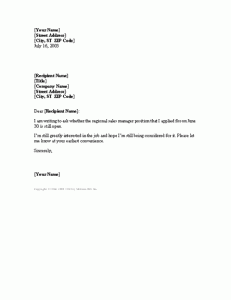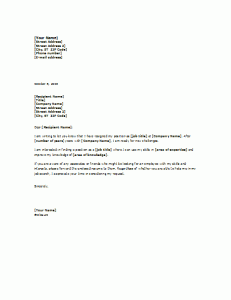18 Post-Deadline Application Communication: Letters for Belated Submissions
Welcome to our page dedicated to helping applicants who have submitted their applications after the initial deadline. We understand that life can sometimes throw unexpected curveballs, causing delays in the application process. But fret not! We’re here to lend a helping hand and provide you with the guidance and support you need. Whether you’re wondering about the status of your late application, seeking an extension, or exploring possible outcomes, we’ve got you covered. We’ve curated a collection of valuable resources and sample letters to address various scenarios. Our goal is to assist you in navigating the challenges that come with late applications and equip you with the right tools to communicate effectively with the relevant parties. So, take a moment to explore the content below and find the letter templates and explanations that best suit your needs. We’re here to help you every step of the way!
#1: Application Receipt Confirmation:
The Application Receipt Confirmation is a letter that acknowledges the receipt of a late application and assures the applicant that their application has been successfully received. It serves as a confirmation that their application is in the system and will be processed accordingly. This letter is important to establish clear communication with the applicant, alleviate any concerns they may have regarding the status of their application, and demonstrate the organization’s commitment to treating all applicants fairly. It also sets the foundation for further communication and interaction throughout the application process, providing a positive applicant experience and maintaining effective communication channels.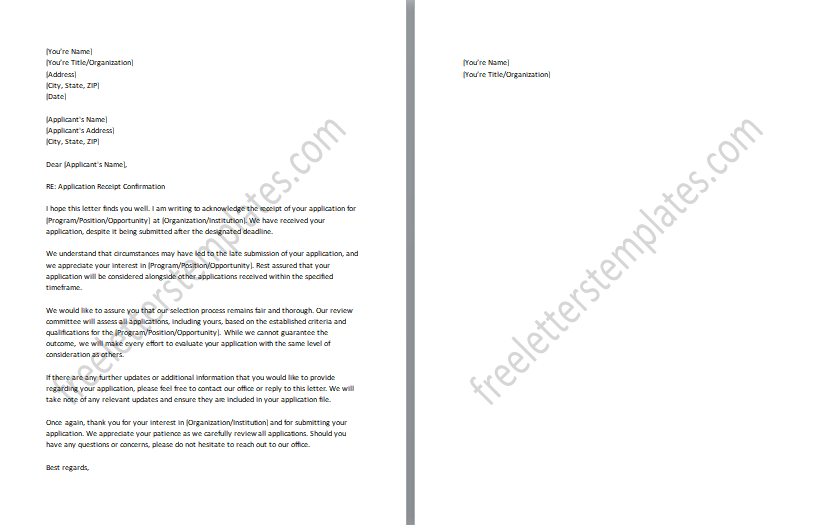
#2: Request for Deadline Extension:
A Request for Deadline Extension letter is a response to a request from an applicant seeking an extension of the application deadline. This letter can either grant or deny the extension based on the circumstances presented by the applicant. Its purpose is to address the applicant’s request while maintaining fairness and adherence to the application process. The letter acknowledges the request, evaluates the reasons provided for the extension, and communicates the decision regarding the extension. If the extension is granted, the letter may provide the new deadline and any additional instructions. If the extension is denied, the letter explains the reasons for the decision and encourages the applicant to submit their application by the original deadline or explore alternative options. The tone of the letter should be professional and considerate, recognizing the applicant’s situation while ensuring the integrity of the application process.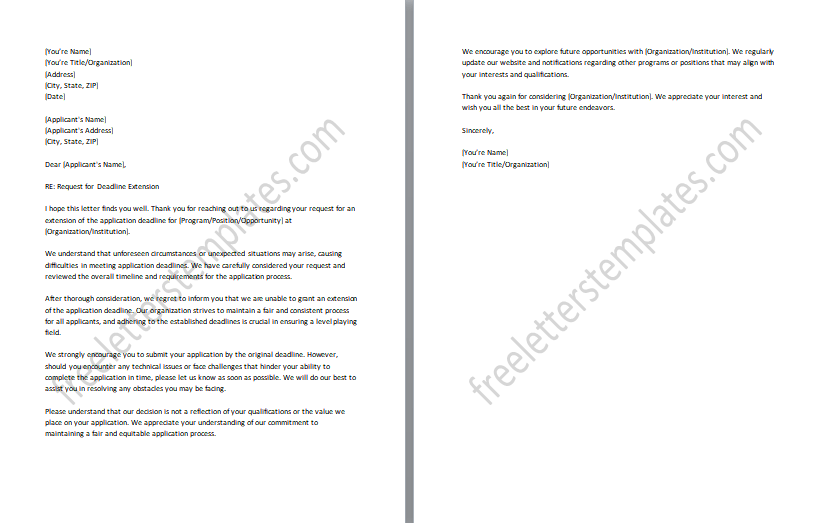
#3: Application Declined:
An Application Declined letter is sent to inform an applicant that their late application has been declined and will not be considered. The purpose of this letter is to communicate the decision regarding their application while being respectful and transparent about the outcome. The letter acknowledges the receipt of the late application, expresses appreciation for the applicant’s interest, and provides a clear statement that their application cannot be further evaluated due to its late submission. It may include a brief explanation of the reasons for declining the late application, such as the organization’s adherence to deadlines and fairness to all applicants. The tone of the letter should be professional and empathetic, recognizing the effort put into the application and encouraging the applicant to consider other opportunities or future application cycles.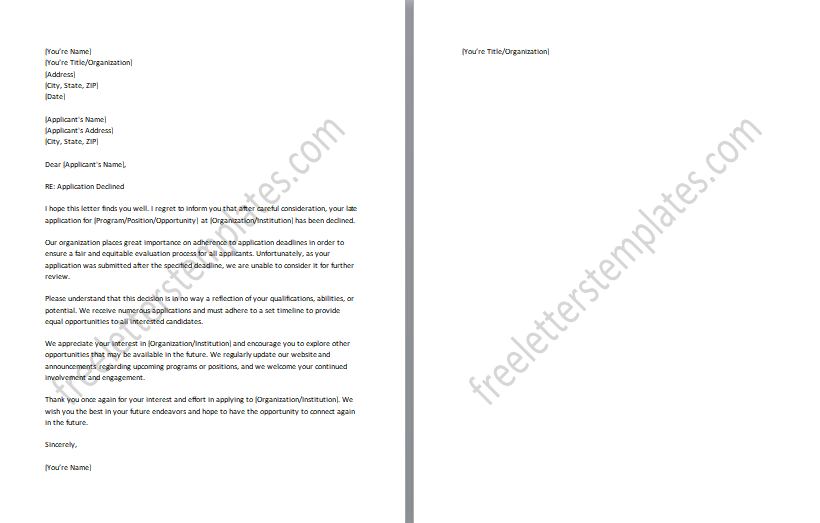
#4: Consideration of Late Application:
A Consideration of Late Application letter is sent to acknowledge a late application and express the organization’s intention to review it, providing hope for potential consideration. The purpose of this letter is to inform the applicant that their late application has been received and will be evaluated despite the missed deadline. The letter recognizes the applicant’s effort and interest in the opportunity, emphasizing that their application will not be automatically disqualified due to late submission. It assures the applicant that their application will undergo the same thorough review process as other applications received on time. The tone of the letter should be encouraging and optimistic, conveying the organization’s commitment to fairness and consideration of all applicants. It may also include a reminder of the importance of meeting deadlines in future applications. The letter concludes by thanking the applicant for their submission and expressing the organization’s appreciation for their understanding and patience throughout the review process.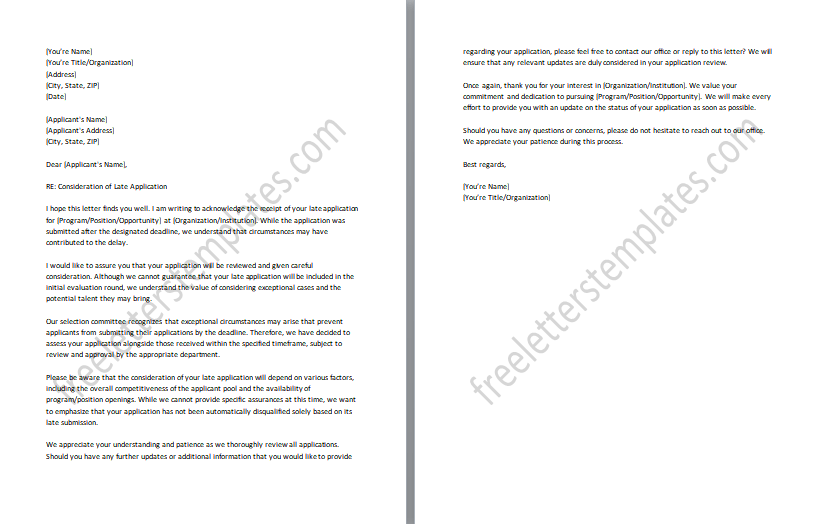
#5: Application Deadline Reminder:
An Application Deadline Reminder letter is sent to remind the applicant of an upcoming application deadline and urge them to submit their application promptly. The purpose of this letter is to ensure that the applicant is aware of the deadline and to encourage them to take the necessary actions to complete and submit their application on time. The letter includes clear and concise information about the deadline, including the specific date and time. It may also provide instructions or reminders about the application process, such as required documents or online submission procedures. The tone of the letter should be professional yet persuasive, emphasizing the importance of meeting the deadline and highlighting the benefits of submitting the application in a timely manner. The letter concludes by expressing gratitude for the applicant’s interest and anticipation of receiving their completed application.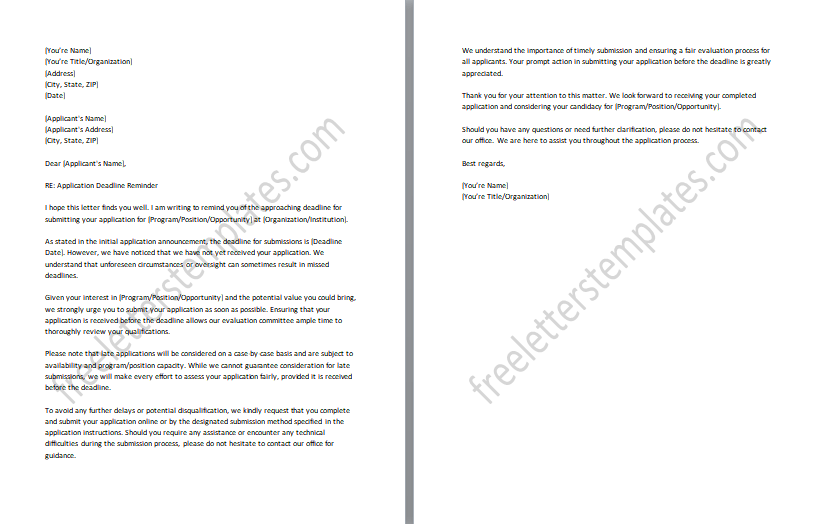
#6: Application Update Request:
An Application Update Request letter is sent to request the applicant to provide any necessary updates or missing information in their late application. The purpose of this letter is to ensure that the application is complete and accurate by requesting the applicant to provide any updates or missing information that may be necessary for a comprehensive evaluation. The letter acknowledges the receipt of the applicant’s late application and expresses appreciation for their interest in the opportunity. It outlines the specific updates or missing information that are required and provides instructions on how to submit them. The tone of the letter should be polite and professional, emphasizing the importance of the requested updates or information in the evaluation process. The letter concludes by expressing gratitude for the applicant’s cooperation and indicating the organization’s willingness to assist with any questions or concerns the applicant may have.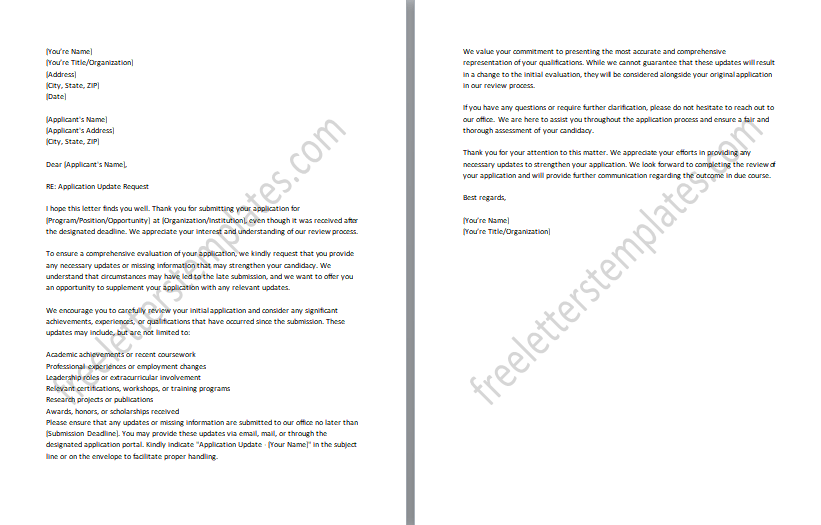
#7: The outcome of The Late Application Review:
An Outcome of Late Application Review letter is sent to inform the applicant of the outcome of the review process for their late application, whether it has been accepted or rejected. The purpose of this letter is to communicate the final decision regarding their application and provide closure to the application process. The letter acknowledges the receipt of the late application, expresses appreciation for the applicant’s interest, and states the decision of acceptance or rejection. In the case of acceptance, the letter may provide additional details or instructions for the next steps in the process. In the case of rejection, the letter may provide a brief explanation for the decision while maintaining a respectful tone. The letter should be professional and considerate, recognizing the effort and time invested by the applicant in the application. It may also provide guidance or alternative options for the applicant to pursue in their future endeavors.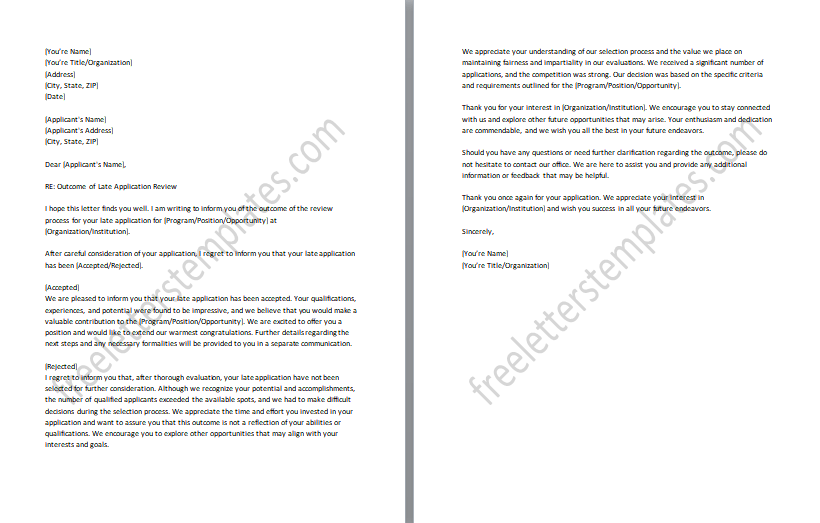
#8: Application Reevaluation Request:
An Application Reevaluation Request letter is sent by an applicant to request a reevaluation of their late application due to extenuating circumstances or the availability of new information. The purpose of this letter is to appeal for a second review of their application based on valid reasons that may have contributed to the late submission or the presence of significant updates. The letter should clearly state the reasons for the request, providing a compelling argument and supporting evidence for reconsideration. It should express gratitude for the initial consideration of the application while highlighting the importance of the additional circumstances or information that warrant a reevaluation. The tone of the letter should be respectful and persuasive, focusing on the merits of the applicant and their commitment to the opportunity. The letter concludes by expressing appreciation for the organization’s time and consideration, and it may also provide contact information for further communication or clarification if needed.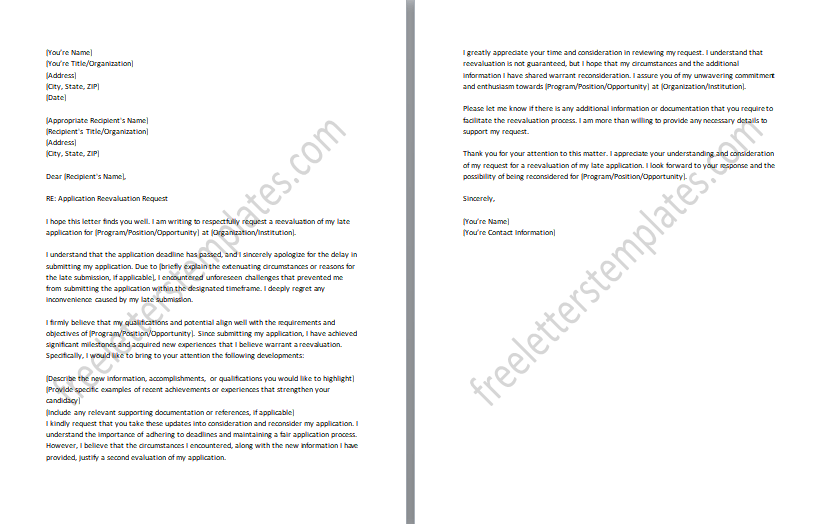
#9: Application Acceptance Confirmation:
An Application Acceptance Confirmation letter is sent to notify the applicant that their late application has been accepted and to provide them with details regarding the next steps in the process. The purpose of this letter is to officially inform the applicant of their successful application and to guide them through the subsequent stages of the process. The letter begins by expressing congratulations to the applicant for their acceptance, acknowledging their late submission, and highlighting the strengths of their application that contributed to the decision. It then provides essential information such as the start date, orientation details (if applicable), required documentation, and any additional actions the applicant needs to take, such as submitting a deposit or completing enrollment forms. The letter should be written in a positive and informative tone, offering support and assistance to ensure a smooth transition into the program or position. It may also provide contact information for any inquiries or concerns the applicant may have. Overall, the Application Acceptance Confirmation letter aims to provide the applicant with confidence and clarity as they move forward in their journey with the organization or institution.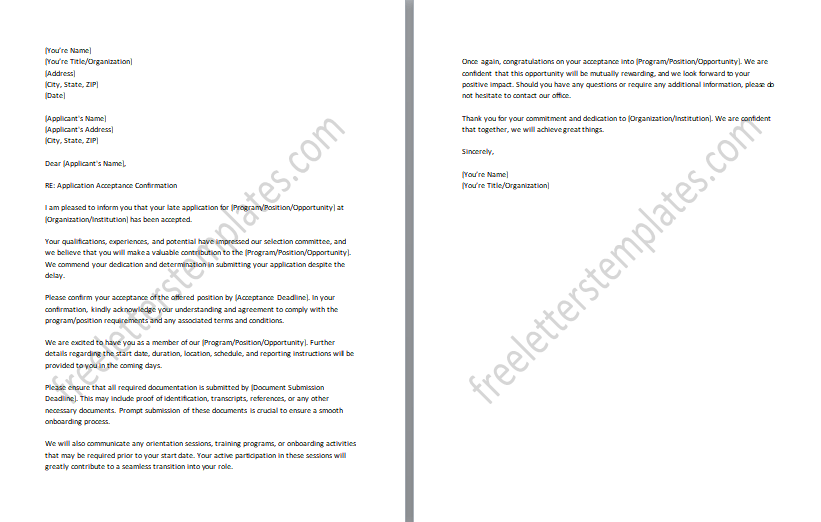
#10: Invitation to Interview for Late Applicant:
A letter inviting a late applicant to an interview as part of the application process serves to extend an invitation to the applicant for an interview, despite their submission being received after the initial deadline. The purpose of this letter is to recognize the applicant’s potential and provide them with an opportunity to further showcase their qualifications and suitability for the position or program. The letter begins by expressing appreciation for the applicant’s interest and effort in submitting their application, even though it was received after the deadline. It highlights the organization’s recognition of their qualifications and the desire to learn more about their skills and experiences through an interview. The letter includes details such as the date, time, and location (in-person or virtual) of the interview, as well as any specific instructions or preparations required. It should convey enthusiasm and encouragement, emphasizing the value placed on the applicant’s potential contribution. The letter concludes by expressing anticipation for the interview and providing contact information for any questions or concerns the applicant may have. Ultimately, the Invitation to Interview letter aims to offer the late applicant an opportunity to showcase their abilities and further engage with the organization or institution in the application process.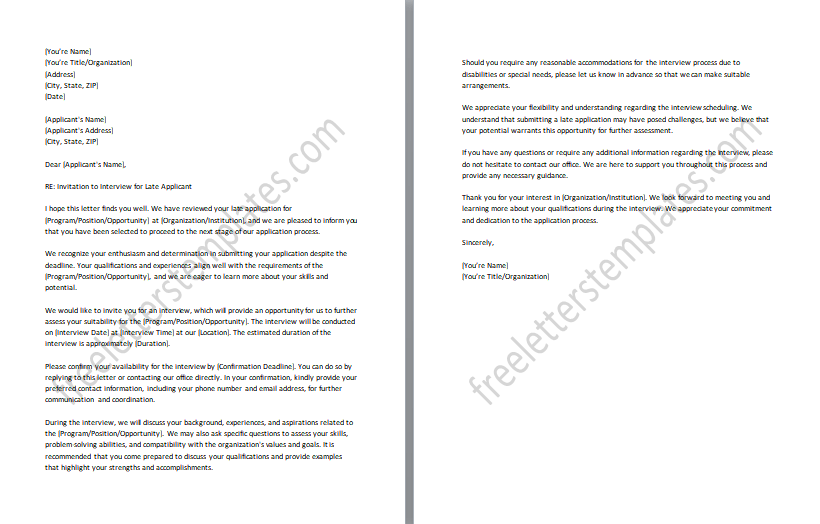
#11: Waitlist Notification for Late Application:
A Waitlist Notification for a Late Application letter is sent to inform the applicant that their application, despite being submitted after the deadline, has been placed on a waitlist. This indicates that while the initial spots may be filled, there is still a possibility of consideration if openings become available in the future. The purpose of this letter is to update the applicant on the status of their application and provide them with information regarding the waitlist process. The letter acknowledges the late submission and expresses appreciation for the applicant’s interest. It explains that due to the high number of applications received, the available spots have been filled but assures the applicant that they are still being considered for admission. The letter may provide information on how the waitlist operates, such as the timeframe for notification or any additional steps the applicant needs to take. It should convey a sense of optimism and encouragement, expressing that the applicant’s qualifications and potential make them a strong candidate for admission if a spot becomes available. The tone of the letter should be positive and transparent, ensuring that the applicant understands their position on the waitlist and the potential for future consideration.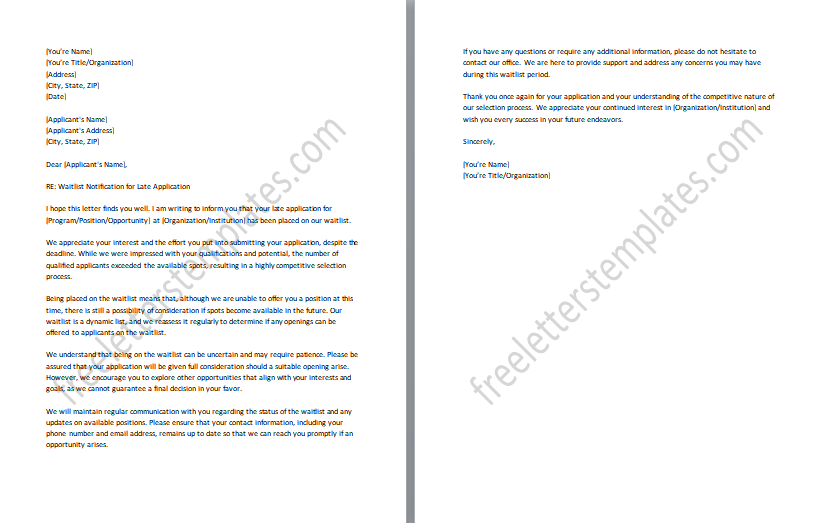
#12: Notice of Reopening Applications:
A letter notifying prospective applicants that the application process has been reopened, allows them to submit their applications after the initial deadline.
A Notice of Reopening Applications letter informs prospective applicants that the application process has been reopened after the initial deadline. It communicates the opportunity to submit applications and provides details about the new deadline and submission guidelines. The letter encourages prospective applicants to take advantage of this chance, emphasizing the benefits and expressing appreciation for their interest. The tone is welcoming and informative, aiming to prompt application submission.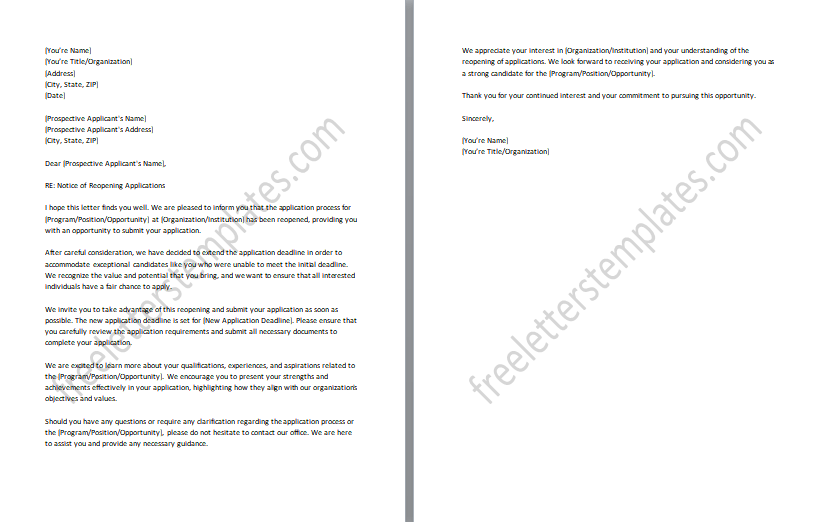
#13: Conditional Acceptance for Late Applicant:
A letter offering conditional acceptance to a late applicant, typically outlining specific requirements or conditions that need to be fulfilled.
A Conditional Acceptance for a Late Applicant letter offers conditional acceptance to an applicant who submitted their application after the deadline. The letter outlines specific requirements or conditions that must be fulfilled for full acceptance. It congratulates the applicant, acknowledges their late submission, and outlines the conditions, such as submitting additional documentation or meeting certain academic benchmarks. The letter expresses confidence in the applicant’s ability to meet the conditions and provides a timeline for compliance. The tone is supportive, emphasizing the organization’s or institution’s commitment to the applicant’s success. Contact information is provided for any inquiries.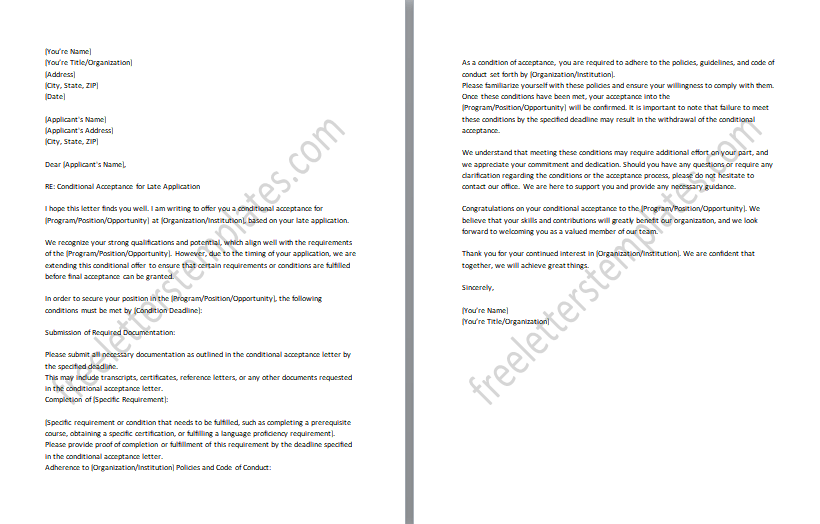
#14: Notification of Deferral for Late Application:
A Notification of Deferral for a Late Application letter is sent to inform the late applicant that their application has been deferred to a later admission cycle or semester. This letter communicates that their application will not be considered for the current cycle but will be reviewed and evaluated in the future. The purpose of this letter is to update the applicant on the status of their application and provide them with information regarding the deferral process. The letter acknowledges the late submission and expresses appreciation for the applicant’s interest. It explains that due to the timing of the application, it cannot be considered in the current cycle but will be reviewed in a subsequent cycle. The letter may provide information on the timeline for the next admission cycle or semester, any additional requirements or updates needed, and any specific instructions for the applicant to follow. The tone of the letter should be informative and supportive, reassuring the applicant that their application will still receive consideration at a later date. It may also provide contact information for any questions or concerns the applicant may have. Overall, the Notification of Deferral letter aims to inform the late applicant about the deferral decision, provide them with clarity regarding the timeline, and maintain a positive and encouraging tone throughout.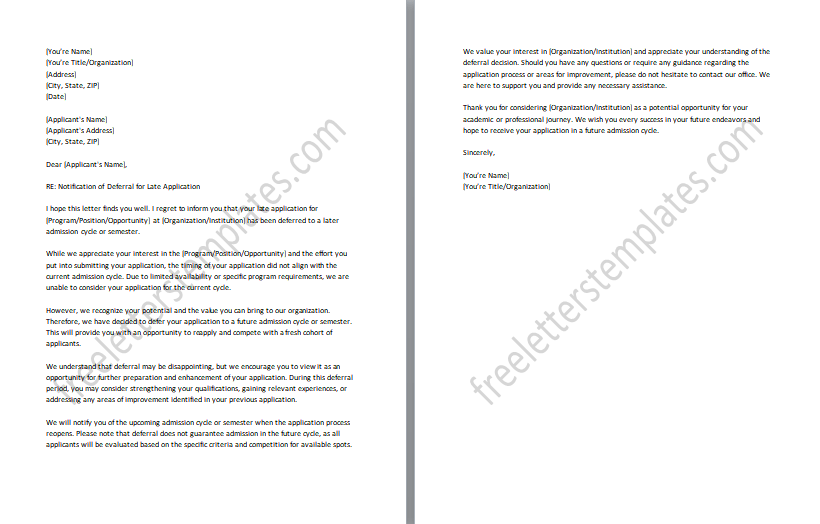
#15: Confirmation of Late Application Withdrawal:
A Confirmation of Late Application Withdrawal letter is sent to acknowledge the late applicant’s decision to withdraw their application after submission. This letter serves to confirm the applicant’s request and formally close their application process. The purpose of this letter is to acknowledge the applicant’s decision, express understanding, and provide assurance that their withdrawal request has been processed. The letter begins by thanking the applicant for their initial interest and effort in submitting their application. It acknowledges that circumstances may have changed or that they have chosen a different path. The letter confirms the withdrawal of their application and assures them that their request has been duly noted and processed. It may also mention any related matters such as the refund of application fees, if applicable. The tone of the letter should be respectful and understanding, emphasizing that the applicant’s decision is respected and accepted. It may also offer best wishes for their future endeavors. The letter concludes by expressing appreciation for their consideration and providing contact information for any further assistance or inquiries. Overall, the Confirmation of Late Application Withdrawal letter aims to acknowledge the applicant’s decision to withdraw their application, ensure proper closure, and maintain a positive and supportive tone throughout.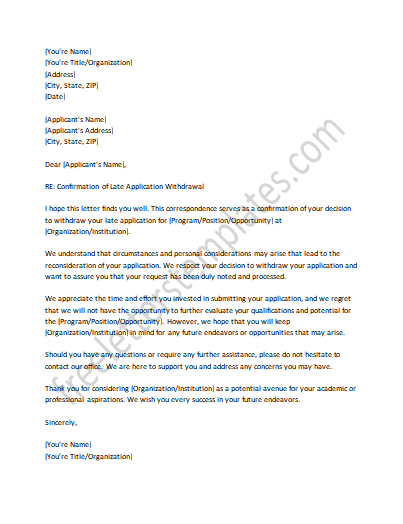
#16: Request for Late Application Documents:
A Request for Late Application Documents letter is sent to remind the late applicant to submit any outstanding documents required for their application. The letter specifies the missing documents and provides instructions on how to submit them. It emphasizes the importance of completing the application and may include a deadline for submission. The tone is professional and helpful, expressing appreciation for the applicant’s attention to this matter. Contact information is provided for any inquiries.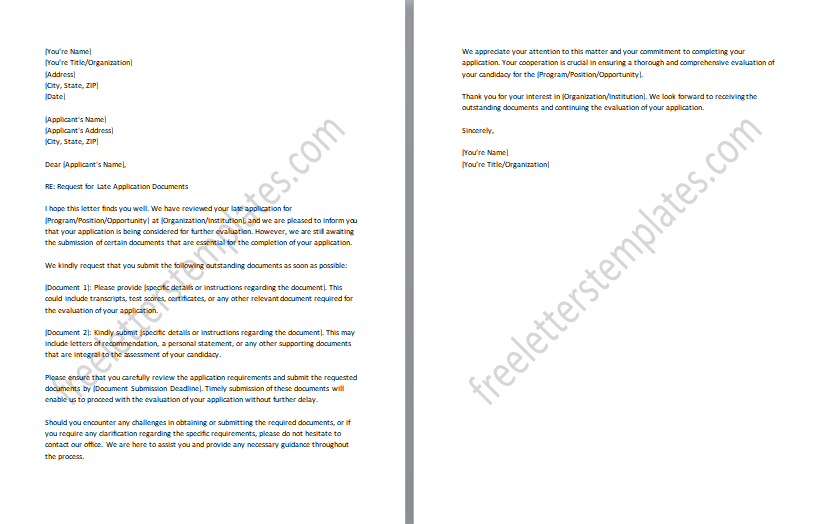
#17: Rescheduling of Interview for Late Applicant:
A letter informing the late applicant of a rescheduled interview due to their application being submitted after the initial deadline.
A Rescheduling of Interview for a Late Applicant letter informs the applicant that their interview has been rescheduled due to their late application. It provides the new date, time, and any additional details. The letter acknowledges the late submission, expresses appreciation for their continued interest, and emphasizes that their application is still being considered. The tone is informative and accommodating, expressing gratitude for their flexibility. Contact information is provided for any further inquiries or assistance.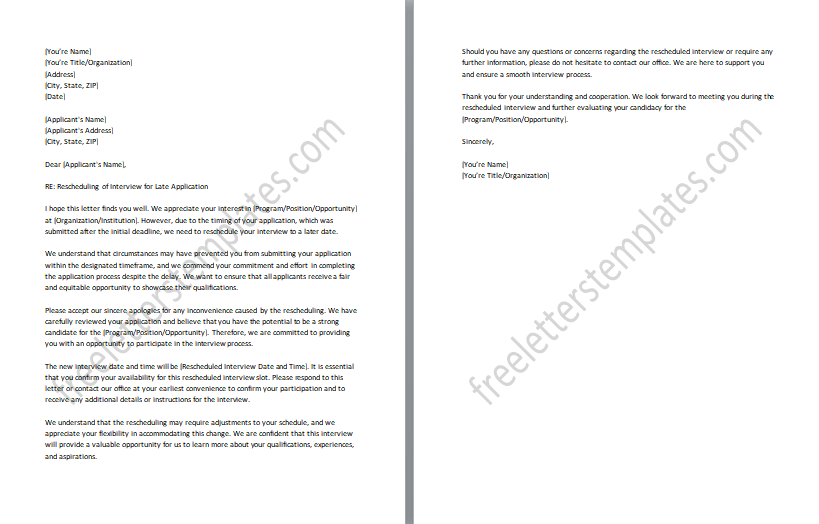
#18: Decision on Late Application Appeal:
A letter communicating the final decision on an appeal made by a late applicant regarding the consideration of their application.
A Decision on Late Application Appeal letter communicates the final decision on an applicant’s appeal regarding their late application. It acknowledges the appeal, states whether it is approved or denied, and provides any relevant details or explanations. The tone is professional and respectful, offering gratitude for the applicant’s interest. Contact information may be included for any further inquiries or options.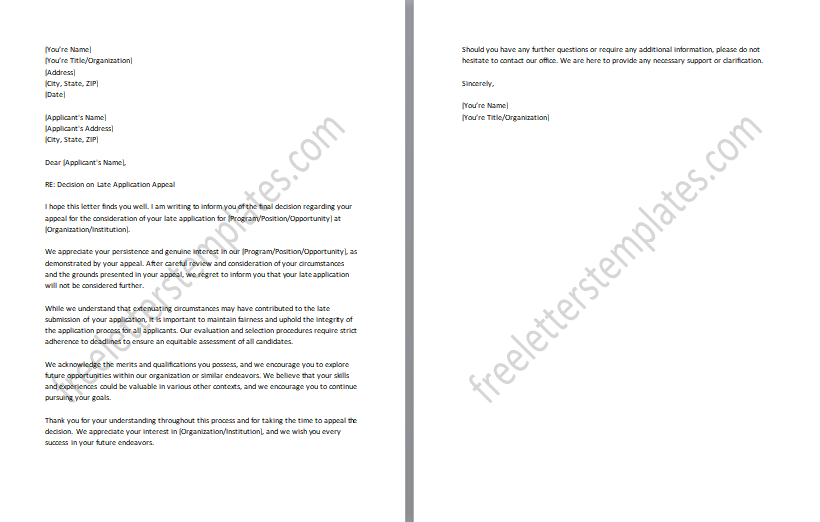
Handling a Missed Application Deadline: Guidance and Actions
- Assess the situation: Understand the reasons why you missed the application deadline. Was it due to unforeseen circumstances, technical issues, or personal reasons? This will help you determine the best course of action.
- Contact the institution or organization: Reach out to the relevant contact person or admissions office and explain your situation. Be honest and provide a concise explanation for missing the deadline. In some cases, they may be willing to make an exception or provide guidance on the next steps.
- Inquire about late application options: Ask if there are any provisions or alternative processes for late applicants. Some institutions may have a grace period or allow late submissions under certain conditions. Explore these options and adhere to any specific instructions provided.
- Prepare a compelling case: If applicable, gather any supporting documents or evidence that can strengthen your case for consideration. This could include recommendation letters, academic achievements, or any relevant information that showcases your qualifications.
- Submit a formal request: If there is a formal process for late applications or appeals, follow the instructions provided and submit a request explaining why you believe your application should still be considered. Clearly articulate your passion, motivation, and why you believe you would be a valuable addition to the institution or program.
- Explore alternative options: If your application is not accepted due to the missed deadline, consider alternative paths. Research other similar programs or institutions with later application deadlines or explore gap year opportunities to enhance your skills and experiences before reapplying.
Conclusion
We hope that the resources and sample letters provided on this page have been helpful in addressing your needs as an applicant who has submitted their application after the initial deadline. Remember, a late application doesn’t have to be the end of the road. By utilizing effective communication and demonstrating your commitment, there may still be opportunities for consideration. Keep in mind that each situation is unique, and it’s important to tailor your approach accordingly. We encourage you to use these resources as a starting point, adapting them to your specific circumstances and maintaining a positive and proactive mindset throughout the process. Remember, setbacks can sometimes lead to unexpected outcomes and opportunities. Stay resilient, and don’t hesitate to reach out if you need further assistance. Wishing you the best of luck in your application journey!
